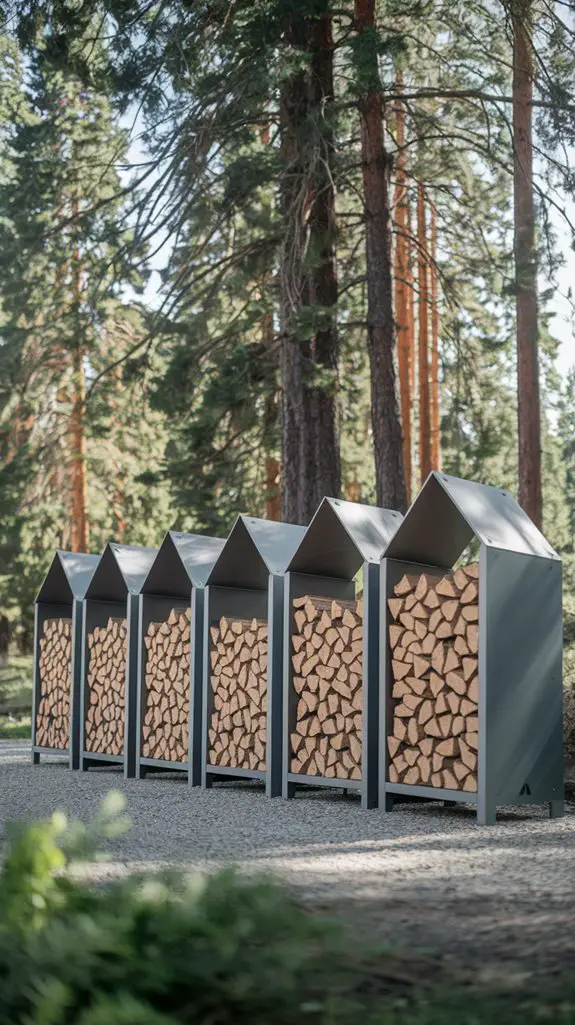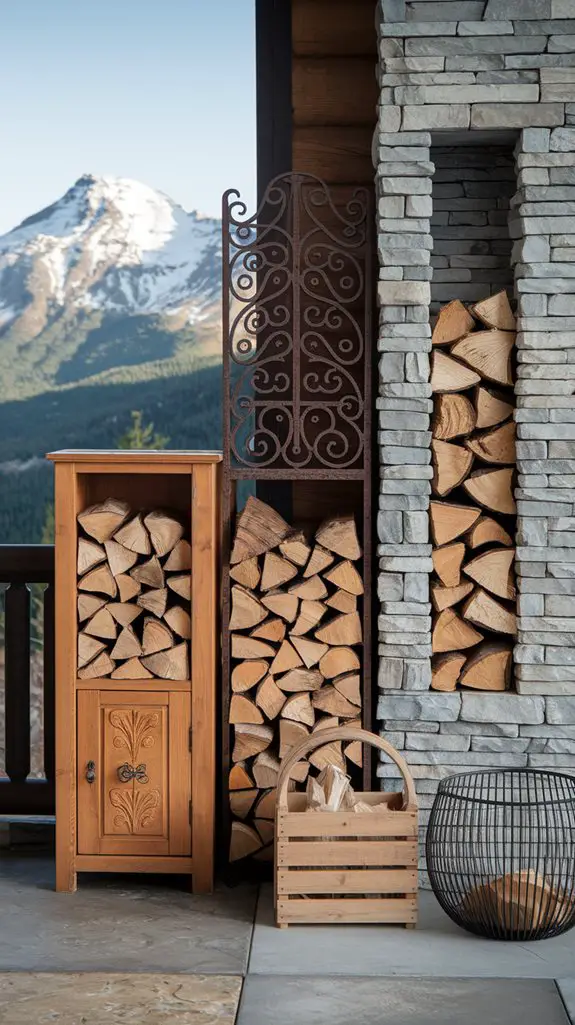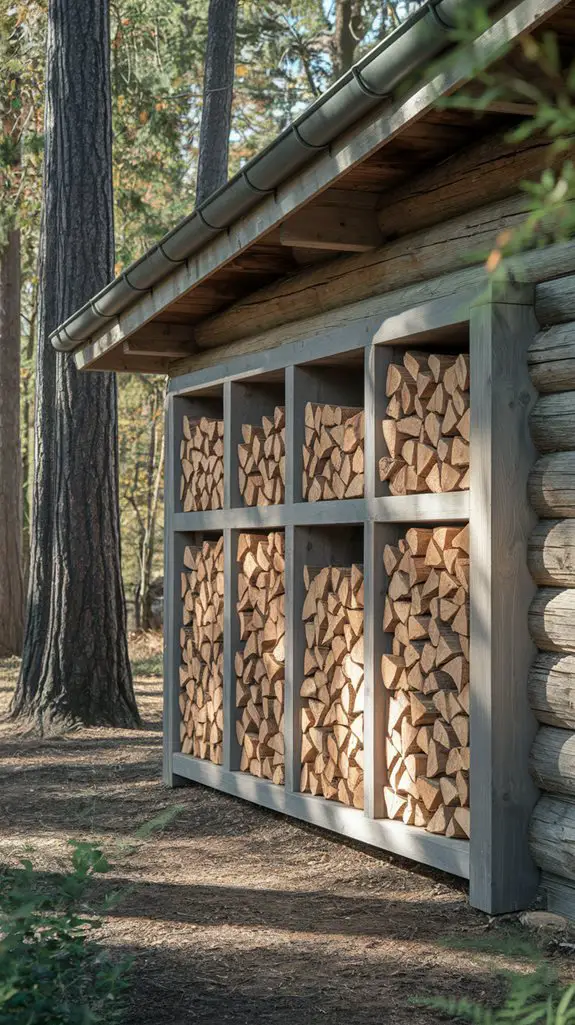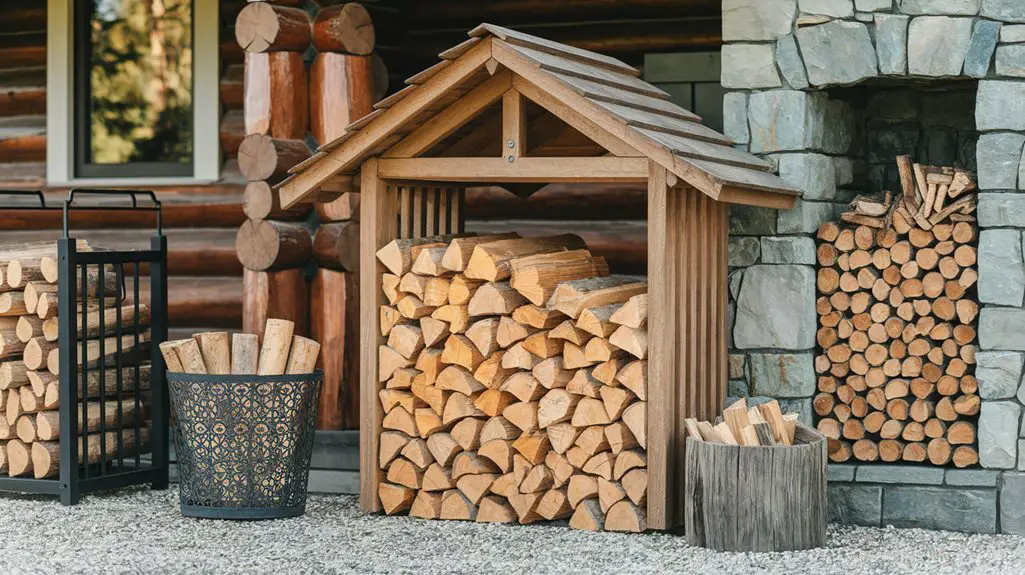Cutting firewood, stacking firewood, and storing firewood define the rhythm of cabin life throughout the seasons. You’ll need a dedicated storage solution that maintains your wood at 15-20% moisture content while complementing your cabin’s architecture. The right system protects your 16-18 inch split logs from precipitation while allowing proper air circulation through 1-2 inch gaps between stacks. These five proven designs balance traditional craftsmanship with practical functionality—each offering distinct advantages for your specific cabin layout.
Outdoor Wood Storage Racks With Protective Covers

When properly designed, outdoor wood storage racks with protective covers represent the ideal solution for cabin firewood storage.
Construct your rack using 2×4 pressure-treated lumber for the frame and 1×4 cedar slats for the base, allowing 1/2″ spacing between slats for proper ventilation.
For peak performance, elevate the rack 6″ above ground level using concrete blocks to prevent moisture absorption. The ideal dimensions measure 4′ high × 8′ long × 16″ deep, accommodating approximately 1/2 cord of split wood.
Select a UV-resistant polyethylene cover with a minimum 6 mil thickness that extends 12″ beyond the wood pile on all sides while maintaining a 2″ gap at the bottom for air circulation.
Secure the cover using bungee cords with ball endings that won’t damage the fabric during high winds. Additionally, consider incorporating built-in seating options into your firewood storage design to enhance functionality and comfort in your outdoor space.
Rustic Log Storage Cabinets for Mountain Aesthetics

Rustic log storage cabinets offer an aesthetic alternative to outdoor racks while maintaining the functional integrity of proper firewood storage. These handcrafted pieces blend seamlessly with cabin interiors, featuring natural wood construction that complements mountain décor.
| Feature | Specification | Design Element | Material |
|---|---|---|---|
| Height | 48″-60″ | Bark-on edges | Pine |
| Width | 30″-36″ | Hand-hewn joins | Cedar |
| Depth | 16″-24″ | Mortise-tenon | Oak |
| Capacity | 0.5-0.75 cord | Metal brackets | Hickory |
When selecting your cabinet, consider moisture-resistant woods like cedar for humid environments. Position your cabinet at least 36″ from active heat sources to prevent fire hazards. Custom options include removable dividers for separating kindling from logs and pull-out drawers for fire starters. Additionally, firewood storage ideas can help maximize your outdoor space and keep your logs organized.
Built-In Firewood Storage Walls for Cabin Exteriors

Built-in firewood storage walls represent an efficient utilization of exterior cabin space while providing practical protection for your wood supply. Construct these integrated units using pressure-treated 2x4s for the frame, spaced 16″ on center for ideal structural integrity.
Install a moisture barrier between your cabin wall and the storage unit—30-pound roofing felt works effectively for this purpose. For proper airflow, elevate the wood stack 4-6″ off the ground using cedar boards, which resist rot naturally.
The depth should measure 16-24″ to accommodate standard log lengths while maintaining proper drying circulation. Cap your structure with a 15° sloped roof to shed precipitation effectively.
Design the face with 1″ gaps between boards to facilitate air movement without exposing your supply to excessive moisture. This configuration guarantees your firewood remains accessible and properly seasoned year-round. Additionally, proper firewood stacking techniques can enhance air circulation and drying efficiency.
Decorative Stone Firewood Enclosures for Weather Protection
Combining both aesthetics and functionality, decorative stone firewood enclosures offer superior weather protection while complementing your cabin’s natural surroundings. Construct these enclosures using 4″-6″ thick fieldstone or manufactured stone veneer applied over a reinforced concrete block base (8″×8″×16″ blocks recommended).
For ideal moisture management, elevate the base 3″-4″ above grade using a #57 crushed stone substrate. Install 1/4″ drainage slope per foot away from your cabin.
The enclosure’s interior should maintain 2″ air gaps between wood and stone surfaces, with a minimum 6″ clearance from ground level.
Top your structure with a 2″-3″ thick natural stone cap featuring a 1″ overhang and drip edge to direct water away. Select stones with 5% or lower water absorption rates for freeze-thaw durability in harsh climates. Additionally, using natural materials for your firewood enclosure can enhance its eco-friendliness and sustainability.
Space-Saving Vertical Firewood Towers for Small Cabin Yards
Vertical storage maximizes your cabin’s limited yard space by capitalizing on height rather than footprint. Standard towers measure 24″ in diameter and reach 60-72″ high, accommodating approximately 1/3 cord of seasoned wood when fully stacked.
Construct your tower using 1/4″ galvanized steel mesh with 2″ openings, secured to four 2×2 pressure-treated posts. Space the posts equidistantly at 90° intervals and anchor them 12″ into the ground using quick-set concrete.
For stability, the base should be 4″ wider than the tower’s diameter.
Top your tower with a 30° pitched cap made from 24-gauge corrugated metal to shed precipitation. Elevate the bottom 6″ using concrete pavers to prevent ground moisture absorption and extend your firewood’s usable life. Additionally, using weather-resistant firewood storage solutions can enhance the durability of your storage against the elements.
Conclusion
You’ve now got five expert-tested options for cabin firewood storage that’ll keep your supply dry and accessible. Significantly, properly stored firewood can reduce moisture content from 45% to the perfect 15-20% range, dramatically improving burn efficiency by up to 35%. When building, make certain your storage dimensions accommodate standard 16″ log lengths with 2″ air circulation gaps between stacked rows for best seasoning conditions.




